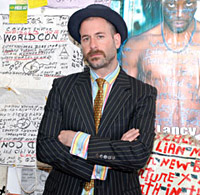Conceptual Plagiarism


What if someone made a book by plagiarizing the newspaper; then six years later someone came along and made a book by plagiarizing that first plagiarism? Answer:
Day by Kenneth Goldsmith (The Figures, 2003)
From the “Author”:
“I am spending my 39th year practicing uncreativity. On Friday, September 1, 2000, I began retyping the day’s NEW YORK TIMES word for word, letter for letter, from the upper left hand corner to the lower right hand corner, page by page.” With these words, Kenneth Goldsmith embarked upon a project which he termed “uncreative writing”, that is: uncreativity as a constraint-based process; uncreativity as a creative practice. By typing page upon page, making no distinction between article, editorial and advertisement, disregarding all typographic and graphical treatments, Goldsmith levels the daily newspaper. DAY is a monument to the ephemeral, comprised of yesterday’s news, a fleeting moment concretized, captured, then reframed into the discourse of literature. “When I reach 40, I hope to have cleansed myself of all creativity.”
Day by Kent Johnson (BlazeVox, 2009)
From the “Author”:
What he said.
Those who follow tradition are ignored

Brion Gysin famously said, “Writing is fifty years behind painting.” And it looks like Kenneth Goldsmith would agree:
What I learned in the art world is that anything goes. The further you can push something, the more it is rewarded: to shoot for anything less in the art world is career suicide. The art that is deemed the most valuable is rarely the most finely-crafted, the most expressive, or the most “honest” works, but rather those which either attempt to do something that’s never been done before or those that synthesize older ideas into something new. Risk is rewarded. Those who follow tradition in a known, dogged, and obligatory manner are ignored. Unlike the poetry world, the mainstream of the art world since the dawn of modernism has been the avant-garde, the innovative, the experimental. The most cutting-edge work — the work with the biggest audience and historical import — has been the most challenging.
–from “The Tortoise And The Hare: Dale Smith and Kenneth Goldsmith Parse Slow and Fast Poetries” in Jacket 38
